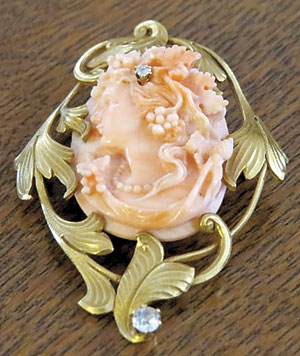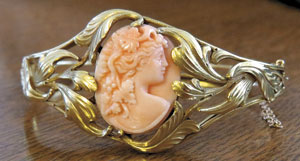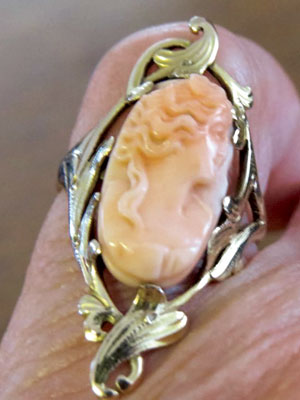
JA sends me a lovely parure of three-coral cameo jewelry pieces. Parure implies a set of three or more matching pieces of jewelry made to match. The history of a cased presentation parure of a matching brooch, bracelet, earrings, pendant and tiara goes back to European royalty, especially the famous Iranian Crown Jewels. Here we find two most celebrated and perhaps the oldest of huge diamond sets, including the 186-carat Darya-i-Nur, or the Ocean of Light. That’s the basis of the tradition of giving a set of jewels, the WOW factor, similar to the parure JA sends me.
The finest parures in history were those given to Napoleon‘s two consecutive wives, Empress Josephine, and, Empress Consort Marie-Louise. You can still see Josephine’s parure worn today. The tiara, the earrings, the necklace and brooch worn by Queen Sonja of the Royal Family of Norway. Two other important historical parures are the ruby and diamond (20th century) parures owned by the Duchess of Windsor as well as her diamond and emerald parure (19th century).
JA’s parure is of antique cameos, very popular in the mid to late 19th century. The first known cameo dates to 332 BC, when the Greeks discovered shell carving, using the different colors of the layers. The first layer is removed and the cameo is then engraved in relief, which means shaped outwardly, not shaped in the round like a sculpture. In another method, intaglio, the cameo is carved out from the back of the profile, and the surface is flat. The little town of Torre del Greco at the base of Mt. Vesuvius on the Bay of Napes became the center of cameo carving.

These miniature sculptured art forms are a window to the trends of the past. Historical events are pictured, as well as famous people and notorious beauties. Above all, because of the center of cameo production at Torre del Greco (the Greek) in Italy, mythological gods and goddesses are often portrayed with Zeus, Hera, Diana, Demeter and Psyche among the favorites. Religious figures such as St. John the Baptist and Mary are worn, as well as horse drawn chariots and animals. Frequently, as in JA’s, a gemstone is included as worn by the figure represented in the cameo.
Cameos are carved from shells, or hardstones such as onyx, sardonyx and carnelian. Less common are lava, malachite, lapis lazuli, ivory and, like JA’s, coral, because these materials lend themselves to intricate high-relief carving. Watch out for 20th century computer laser art cameos which look to me like Barbie doll profiles with flattened relief and pug noses and are sometimes faked in glass, which warms up quicker in your hand than organic material.

JA writes that the ring pictured was given by her future mother-in-law in the 1960’s. When she married, her mother-in-law presented her with the whole set for her wedding dress. Recently, her daughter wore the set at her wedding here in Santa Barbara, in honor of her grandmother.
The set is from the 1890’s and is worth more than most cameos because of the high relief of the face – she is almost carved in half round. Also, the diamond feature, and the use of coral, which is a great pink color, more desirable than the orange coral. More than that, because it’s a matched set, in gold vermeil, which is sterling silver with an over plating of 14k gold. I put the value of the parure at $800.